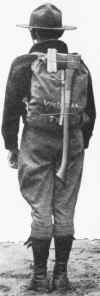By Peter McLaren
The Boys' Axe

Fig. 64.
Proper method of carrying the Boys' Axe on hike.
Note that edge is protected.
While the scout axe is the ideal axe for carrying on a hike, and for general scout work, every camp should be equipped with one or more boys' axes.
This pattern is an exact duplicate of the large chopping axe, except that the weight does not exceed two and one-half pounds, and the handle length is only about twenty-eight inches.
It is just as efficient in use, within the limitations of its size, as the large axe. Logs or trees up to twelve inches in diameter can be cut with facility.
I would warn against the practice of appointing one of the larger boys as the official camp chopper, limiting the use of the boys' axe to him alone. Let every boy master the technique of chopping with a two-hand axe.
Again the contest idea may be evoked to create interest. The scoutmaster should be able to devise a number of demonstrations with certain standards of proficiency.
Keep a record of each boy's progress as a mark upon which he can improve.
The preceding chapters of this book, dealing with the care and use of the men's chopping axe, cover in all essential points the care and use of the boys' axe.
The filing and honing may be made the basis of one demonstration.
The proper grips, position on log, and correct angle for chopping could be taken up in another demonstration.
Then stage a log chopping demonstration. Select an eight- inch log and have the boys chop half-way through it, giving scores on the cleanness of the cut, the angle of cut, and the correctness of forehand and backhand strokes used.
Then give a demonstration on a similar log in which it is to be chopped clear through.
Give credits an the same basis as in the preceding demonstration, and in addition, give credits to the boys whose two notches come closest to meeting perfectly as the log is severed.
Finally let the boys who have attained a certain standard chop against each other, crediting each up to 60 points for skill and up to 40 points for speed.
Skill comes with practice. Post a record of the chopping time made. The boys will soon be clamoring for another contest, for an opportunity to lower the camp record.
Complete details for cutting a log are pictured and described in Chapter 3, and complete rules for conducting a contest are given in Chapter 7.
Encourage the use of the boys' axe at every opportunity. Some troop, somewhere in America, contains a boy who is going to carry the title of Boy Scouts' Champion Chopper. (See reference to Scouts' National Championship Contest on page 60.)
Every boy should have a respect for the axe--but not a fear of it. Study carefully the precautions noted in the chapter "Playing Safe." Impart to your boys the need of caution--just as you would warn them of deep water, without discouraging the mastery of swimming.
In travel, the boys' axe should be attached to the pack, with the edge protected and the handle pointing downward, as pictured in Figure 64.